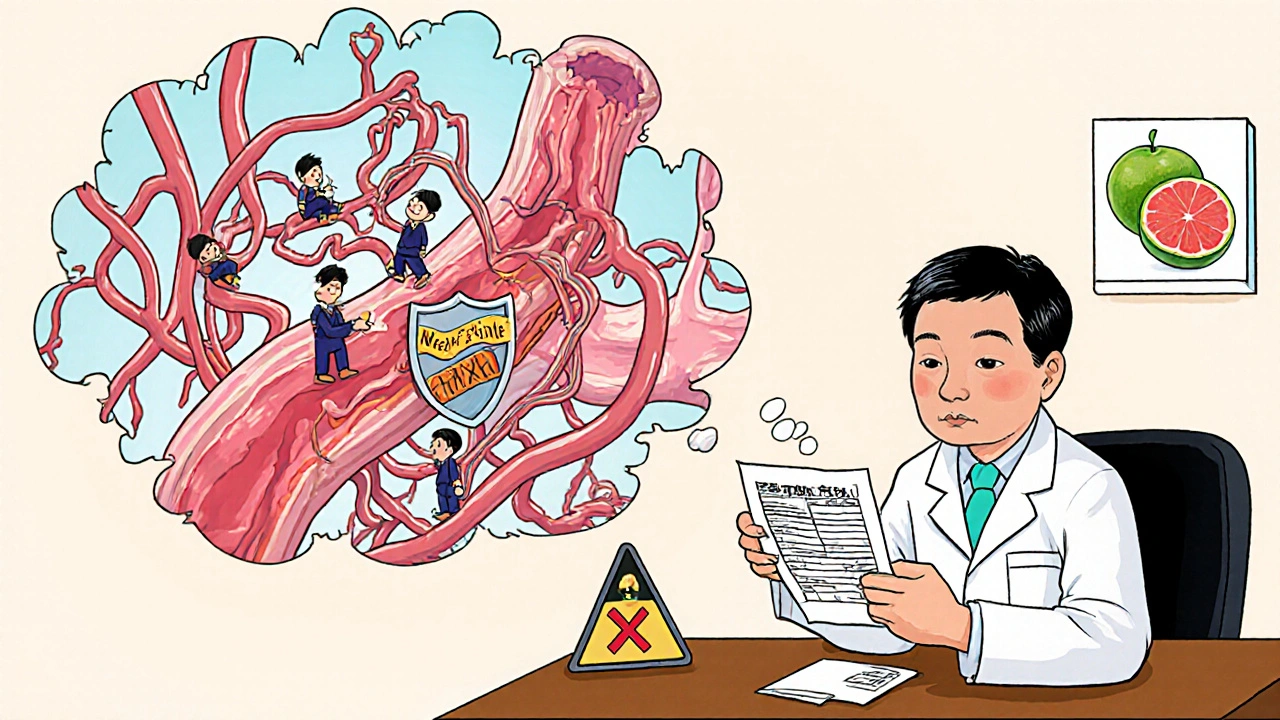Procardia isn’t a supplement you pick up at the health store. It’s a prescription medication with real, measurable effects on your heart and blood vessels. If you’ve been prescribed Procardia, you’re likely dealing with high blood pressure or chest pain from angina. This isn’t about vague wellness trends-it’s about a drug that’s been used since the 1980s to keep hearts working under pressure, literally.
What Procardia Actually Is
Procardia is the brand name for nifedipine, a calcium channel blocker. It works by relaxing the muscles in your blood vessel walls, which lets blood flow more easily. That lowers your blood pressure and reduces the workload on your heart. The generic version is just called nifedipine, but Procardia is still widely prescribed, especially in extended-release form.
It’s not a quick fix. You don’t take Procardia for a headache. It’s meant for long-term management. People on it often take it once or twice a day, depending on the formulation. The extended-release tablets (Procardia XL) are designed to release the drug slowly over 24 hours, so your blood pressure stays steady instead of spiking and crashing.
How Procardia Works in Your Body
Your heart and arteries are made of muscle. When these muscles tighten, your blood vessels narrow. That raises pressure. Calcium plays a key role in making those muscles contract. Procardia blocks calcium from entering the muscle cells in your arteries. Less calcium means less contraction. The vessels relax. Blood pressure drops.
This isn’t magic. It’s physics and biology. Studies show that within 30 to 60 minutes of taking an immediate-release dose, blood pressure starts to fall. Peak effect hits around 2 to 3 hours later. For the extended-release version, the drop is slower but lasts all day. That’s why doctors prefer XL for most patients-it’s more consistent.
Procardia doesn’t just help your arteries. It also improves blood flow to the heart muscle itself. That’s why it’s used for angina. When your heart doesn’t get enough oxygen, you get chest pain. Procardia opens up the coronary arteries, letting more oxygen-rich blood reach the heart.
Who Gets Prescribed Procardia
Procardia isn’t for everyone. It’s mainly used for two conditions:
- High blood pressure (hypertension): Especially when other drugs like ACE inhibitors or diuretics haven’t worked well enough.
- Chronic stable angina: Chest pain that comes on during physical activity or stress, not from a heart attack.
It’s also used off-label for preterm labor in some cases, because it can relax uterine muscles. But that’s not its primary use, and it’s only done under strict hospital supervision.
Most patients on Procardia are over 40. It’s less common in younger people unless they have severe hypertension or a genetic condition like familial hypercholesterolemia. It’s also used more often in people who can’t tolerate beta-blockers due to asthma or slow heart rates.
What to Expect When You Start Taking It
When you first start Procardia, you might feel dizzy, especially when standing up. That’s because your blood pressure drops faster than your body adjusts. It’s not dangerous, but it’s uncomfortable. Most people get used to it in a week or two.
Headaches are common too. That’s actually a sign it’s working-your blood vessels are widening. Swelling in the ankles (edema) is another frequent side effect. It’s not serious, but it can be annoying. Wearing compression socks and avoiding long periods of standing helps.
Some people report flushing or a warm feeling in their face. Others notice their heart beating a little faster. That’s because the heart tries to compensate for lower blood pressure by pumping harder. It’s normal, but if your heart races above 120 beats per minute or you feel faint, you should call your doctor.
Don’t take Procardia with grapefruit juice. It’s not a myth. Grapefruit interferes with how your liver breaks down nifedipine. That can cause levels in your blood to spike dangerously high. Even one glass can make a difference. Stick to water, tea, or orange juice.

Procardia vs. Other Blood Pressure Meds
There are dozens of drugs for high blood pressure. So why Procardia?
| Medication | Type | Common Side Effects | Best For | Not Ideal For |
|---|---|---|---|---|
| Procardia (nifedipine) | Calcium channel blocker | Dizziness, swelling, flushing, headache | Older adults, patients with angina, those who can’t take beta-blockers | People with severe aortic stenosis, those who drink grapefruit juice regularly |
| Lisinopril | ACE inhibitor | Cough, high potassium, dizziness | Diabetics, patients with kidney disease | People with history of angioedema |
| Metoprolol | Beta-blocker | Fatigue, slow heart rate, cold hands | Patients with heart failure, post-heart attack | People with asthma or severe bradycardia |
| Hydrochlorothiazide | Diuretic | Dehydration, low potassium, frequent urination | Patients with fluid retention, older adults | People with gout or kidney stones |
Procardia stands out because it doesn’t affect your heart rate like beta-blockers do. It doesn’t cause a dry cough like ACE inhibitors. And it doesn’t make you pee constantly like diuretics. That makes it a solid choice for people who’ve had bad reactions to other drugs.
What You Should Avoid
Procardia is generally safe, but there are red flags:
- Don’t stop suddenly. Stopping Procardia cold turkey can cause your blood pressure to rebound, sometimes dangerously high. Always taper under medical supervision.
- Avoid alcohol. It can make dizziness and low blood pressure worse.
- Check with your doctor before taking OTC meds. Cold and flu remedies often contain decongestants like pseudoephedrine, which can raise blood pressure and cancel out Procardia’s effect.
- Watch for signs of liver problems. Rarely, nifedipine can cause liver enzyme changes. If you notice yellowing skin, dark urine, or persistent nausea, get tested.
Also, don’t use Procardia if you’ve had a recent heart attack (within the last week). In that case, other drugs like beta-blockers or ACE inhibitors are safer.
How Long Until You See Results
Some people feel better in a few days. Others take weeks. Blood pressure doesn’t drop dramatically overnight-it levels out gradually. Your doctor will likely check your pressure after 2 weeks, then again at 4 to 6 weeks.
For angina, you might notice less chest pain during walks or stairs. If you’re still having symptoms after 4 weeks, your dose may need adjusting. Don’t assume it’s not working. Sometimes it takes time.
Procardia doesn’t cure high blood pressure or angina. It manages them. You’ll likely be on it for years. That’s normal. Many people take blood pressure meds for life. The goal isn’t to get off it-it’s to stay healthy while on it.

What Happens If You Miss a Dose
If you miss a dose of immediate-release Procardia, take it as soon as you remember. If it’s almost time for your next dose, skip the missed one. Don’t double up.
For Procardia XL, the same rule applies. But because it’s extended-release, missing a dose can cause a bigger spike in blood pressure. If you miss more than one day in a row, call your doctor. Don’t just restart without checking in.
Set phone reminders. Use a pill organizer. These aren’t just suggestions-they’re practical tools that keep people out of the ER.
When to Call Your Doctor
Most side effects are mild. But call your doctor right away if you have:
- Chest pain that’s new, worse, or lasts longer than usual
- Severe dizziness or fainting
- Swelling in your hands, feet, or face
- Difficulty breathing
- Fast, irregular, or pounding heartbeat
These aren’t common, but they’re serious. Procardia is generally safe, but like all meds, it has risks. Knowing the warning signs matters more than knowing the chemical structure.
Is Procardia the same as nifedipine?
Yes. Procardia is the brand name for the drug nifedipine. The active ingredient is identical. Generic nifedipine is cheaper and works the same way. Most doctors will prescribe the generic unless there’s a specific reason to use the brand.
Can I take Procardia with other heart medications?
Often yes, but it depends. Procardia is commonly combined with beta-blockers, ACE inhibitors, or diuretics. But combining it with other blood pressure drugs can lower your pressure too much. Always tell your doctor what else you’re taking, including over-the-counter meds and supplements.
Does Procardia cause weight gain?
Not directly. But some people gain weight because of fluid retention (swelling in the ankles). This isn’t fat-it’s water. Reducing salt intake and elevating your legs can help. If swelling is severe, your doctor might add a diuretic.
Is Procardia safe during pregnancy?
It’s sometimes used off-label to stop preterm labor because it relaxes uterine muscles. But it’s not approved for this use in most countries. If you’re pregnant or planning to be, talk to your OB-GYN. There are safer options for managing high blood pressure during pregnancy, like labetalol or methyldopa.
How long do I need to take Procardia?
For high blood pressure or angina, it’s usually long-term-sometimes lifelong. Stopping it without medical advice can cause your condition to return quickly. If your blood pressure improves due to weight loss or exercise, your doctor might reduce your dose, but don’t stop on your own.
Final Thoughts
Procardia isn’t flashy. It doesn’t make headlines. But for millions of people, it’s the reason they can walk without chest pain, sleep without waking up with a pounding heart, and live without fear of a stroke. It’s not perfect. It has side effects. It requires discipline. But it works.
If you’re on it, stick with it. If you’re considering it, ask questions. Understand why you’re taking it, not just that you’re told to. High blood pressure and angina don’t care how you feel on a Tuesday. They’re silent, slow-moving threats. Procardia is one of the tools that keeps them at bay.

Been on Procardia for 3 years. My BP is stable and I don't get chest pain anymore. Seriously, it's a lifesaver. 🙌